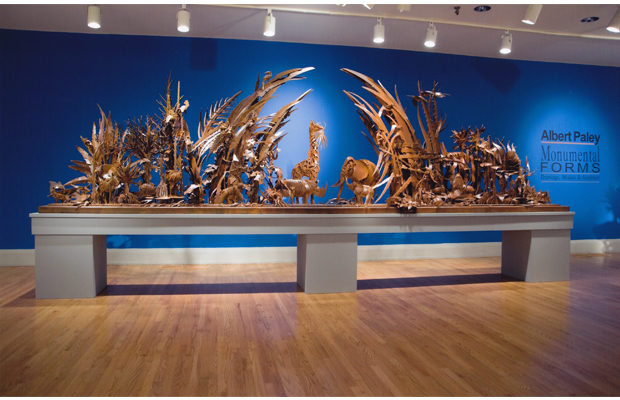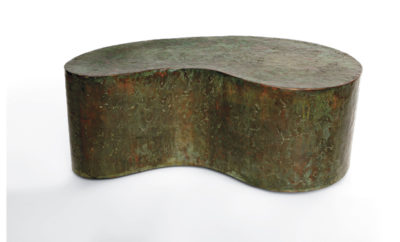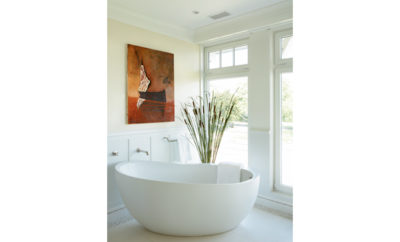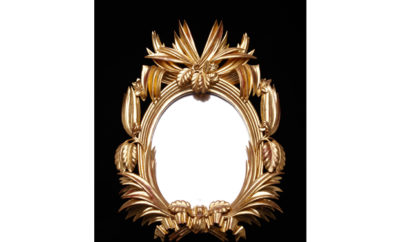
Design
The Insider

Dudley curated and installed the exhibition Monumental Forms: Drawings, Models and Sculpture by Albert Paley held at the Academy Art Museum in Easton, Maryland, December 2008 to February 2009. Pictured is the 2005 formed and fabricated mild steel model for Paley’s “Animals Always” archway at the Saint Louis Zoo of 2006.
The Insider
Perhaps the ultimate stealth tastemaker, Lorry Dudley has been quietly shaping the design sensibilities of Americans for the past thirty years
It’s difficult to talk about the last few decades of contemporary design in the United States without mentioning Lorry Dudley. She introduced Memphis group designs to the U.S. market, helped open the seminal Peter Joseph Gallery of studio design in New York, worked with Wendell Castle, and is now the head of the Italian-based design firm MorosoUSA. Here she discusses working with the late architect and creative eminence Ettore Sottsass, the synergy between industrial design and studio furniture, and the quest to communicate the essence of great design work, big or small.
Brent Lewis: You’ve been promoting design, mostly Italian, in America for over thirty years. What has kept you interested in this field?
Lorry Dudley: In Italy furniture design is all about life, where elsewhere it is about fulfilling a criterion. Sottsass said it best in speaking about Memphis design’s chief goal: for the furniture object to become a consoling and reassuring presence with communicative impact.
Through your work representing Memphis you got to know Ettore Sottsass quite well.
Lucky, lucky me. He was an immeasurable genius.
Who was your initial audience?
Anyone I could get to listen, but there was a small group of open-minded architects and designers along with art and decorative arts collectors who knew this would permanently change the culture.
How were you able to market this shockingly new work to an audience who felt that a Barcelona chair was representative of contemporary design?
In the early 1980s there was also a movement in the U. S. toward “art furniture” by makers such as Frosty Meyers and Terrence Main at Art et Industrie in New York. Modernism as a whole hadn’t evolved much past the 1960s, and most architects simply specified the Bauhaus era pieces out of habit. Some, however, were ready for a change, but didn’t know how to access it. This was decades before the Internet, and word was slow to travel. I searched for completely new furnishings for a house I was building at the time, and found these radical Italians producing incredible objects. Nobody else was importing them to the U.S., so I bought a container-full, and became the defacto U.S. rep for Memphis Milano. I think I spent $10,000!
You eventually opened a showroom, designed by Sottsass, in Dallas. What was the reaction? Who were your clients? Did designers and architects get the message?
I figured that if I wanted “new design,” maybe there were others like me in the States who would, too. The showroom opened in July 1984, and the space was breathtaking— Sottsass designed a pure white temple with a Lego-like, primary colored façade to perfectly display this new design in a residentially referenced palace. Both Time and Newsweek did stories on Memphis, the new design featured in our showroom. I was certain this meant imminent success and I remember waiting for the telephone to start ringing…the only call was from Addie Powell from Swid Powell, recommending we collaborate, which was the start of another great relationship. But curiosity seekers began to visit, tour groups came through, collectors sought us out, and architects and designers were often heard debating the validity of “new design.” Early clients included Sydney and Frances Lewis of Best Products fame, who began collecting modern design and decorative arts when they emptied their home and donated their incredible collection of art nouveau and art deco furnishings to the Virginia Museum of Fine Arts in Richmond. They needed to completely start over to furnish their historical town house and knew it was impossible to replace what they donated, so began collecting the very best in contemporary decorative arts and studio furniture. Other early projects included a hair salon, a psychiatrist’s office, and a few celebrity homes including Martina Navratilova’s.
Later, you began organizing exhibitions, at institutions like the Memphis Brooks Museum of Art and the Cooper-Hewitt. Was this primarily to educate?
Yes, I knew that in order for people to accept the new design, they needed to see it in a museum context and to feel museums agreed that it was a monumental change in design.
Sottsass left Memphis in 1986. How did that affect your business?
Funny, it broke my heart. But Memphis continued to bring out new pieces every year and most of the other core designers were still associated with it. To Sottsass, Memphis had accomplished its mission and his presence wasn’t necessary any longer.
You also brought the Cleto Munari “Jewelry by Architects” collection to America. Was Sottsass the connection there?
Ettore and Barbara Radice introduced me to Cleto and recommended we work together for an exhibition of the Munari jewelry. Barbara wrote the book and Ettore designed a large portion of the collection. I found the venues and installed the show at each location. It’s interesting to note that it was important to Cleto for the exhibition to be shown in museums, but the museums were afraid it might be considered commercial so they required the collection not to be for sale while it traveled.
And then, in a big change of pace, you went up to Rochester to run Wendell Castle’s studio in about 1990? How did you end up working with Wendell?
In the late 1980s we exhibited some American design at the showroom and represented the Arc Collection by Joe Duke. Wendell had designed some beautiful dining chairs for that collection, and we sold quite a lot of them. Once we closed the showroom, due to the recession in Texas in 1988, Wendell called me to help reorganize his studio and establish new outlets for his work. I was able to bring my contacts into play and Wendell expanded his studio to keep up with the demand. One of his newest patrons was Peter T. Joseph, whose contact with Wendell and other furniture artists revealed the lack of a mainstream representation for American studio furniture, as it began to be called. He envisioned a prestigious New York gallery showing the best of the studio movement and he hired me as its founding director.
And that was the Peter Joseph Gallery. What other artists did you represent?
Albert Paley, Gaetano Pesce, Wendy Maruyama, Thomas Hucker, James Carpenter, Jonathan Bonner, John Dunnigan, Michael Hurwitz, Thomas Loeser, Alphonse Mattia, Rosanne Somerson, Timothy Philbrick, James Schriber, Richard Scott Newman, Wendy Wahl, Ed Zucca, and Michelle Holzapfel.
Had most of these artists been shown in New York?
And that brings up another question: Did you refer to them as artists? Designers? Craftsmen/women?
Yes, we always referred to them as artists. Certainly Albert Paley, Wendell Castle, James Carpenter, and Gaetano Pesce had previously shown work in New York City. Others had shown in the original Workbench Gallery and many were represented by the Pritam and Eames Gallery in East Hampton.
Did you find yourself having the same conversation with clients you had when you were working with Memphis?
For me the conversation is always the same. A great work communicates. If a sideboard has a number of framed photographs on it that tell part of the story of the owner and those relationships, then the design of the sideboard should be able to represent a relationship to its owner too.
Do you still feel, working with Moroso, that you have the same responsibility of communication and education to a new audience?
Patrizia Moroso constantly takes risks with designers, passionately encouraging them to explore new ideas and techniques, and bravely brings the results to market. These works are fresh and challenging, and often extraordinary. My job is to communicate that story. As with Memphis, and studio furniture, it is the story—the context and content of the design—that brings an emotional response and a personal connection that speaks to the buyer.
Do you follow the secondary market for design? Or is your interest solely in the new?
I do follow the secondary market, and oh so often wish I had unlimited funds. My passion is always with designs after 1950: those pieces that I feel propelled design and decorative arts to greater heights.
So what’s your collection like?
Incredibly eclectic, as it is with most long term collectors. Since I started my career in the art world, I have many prints, posters, and photographs that I have collected over the years. I still own many of the Memphis pieces that traveled with the exhibitions, Vitra favorites by Verner Panton, Prouvé, and Eames, along with Swid Powell and Alessi prototypes and production pieces. There are, of course, personal favorites from Albert Paley and Wendell Castle, along with an ever changing collection of important pieces of my husband Peter’s sculpturally carved furniture.
Obviously the design market has changed a great deal since thirty years, but do you feel the work has remained on par?
I think this moment is particularly rich in innovation, experimentation, and communication. The intricacy and improvisation possible with new technologies allow designers to make works that are still personal, quite the opposite of our usual expectation of manufactured goods. This will be considered a golden age of design, when anything was possible.
What’s next?
I see a new generation coming up that has learned to expect modern design, yet passionately searches out sentimental, personal talismans. Design is becoming less “idealized” and more “individualized”.












